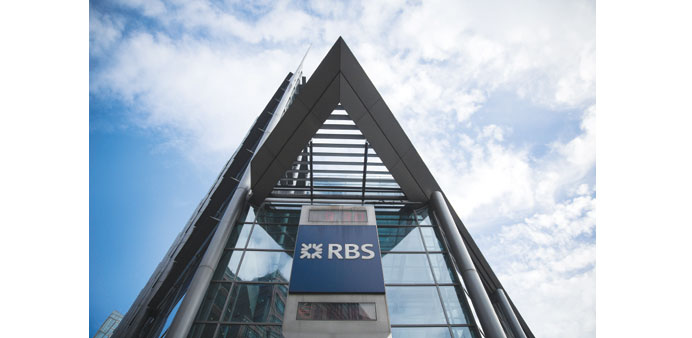Bloomberg
London
Royal Bank of Scotland Group may cut more than two thirds of its investment-bank jobs as part of a plan to shrink the securities unit and focus on the UK consumer market, a person with knowledge of the matter said.
Under an overhaul, announced last week, RBS may eliminate as many as 14,000 jobs at the investment bank, said the person who asked not to be named because the details are private. The Edinburgh-based firm’s corporate and institutional bank, housing most of the securities activities, employs 16,000 to 18,000 people, out of a workforce of more than 108,000. RBS hasn’t finalised the plans on job cuts, the person said.
Chief executive Officer Ross McEwan, 57, on February 26 forecast “significant” job cuts at the investment bank as the government-owned lender posted its seventh straight full-year loss. As part of his restructuring program, the CEO plans to cut the number of countries in which the securities unit operates by two-thirds and shrink US operations.
“The retreat by RBS in investment banking has been going on for a number of years — this is really just the next phase,” Sandy Chen, an analyst at Cenkos Securities in London, told Bloomberg Television’s Francine Lacqua and Guy Johnson on Wednesday. It’s driven “by increased capital and regulatory requirements to pull back from investment banking activities in general,” he added.
The Financial Times reported the 14,000 job cuts earlier.
The bank’s shares were little changed at 370 pence at 11:25am in London, and are down about 6% this year.
RBS plans to cut risk-weighted assets at the investment bank from £107bn to about £35bn to £40bn in 2019.
The CIB division, headed by Rory Cullinan, posted an operating loss of £643mn in the fourth quarter compared with a loss of £557mn in the previous three months. Income in the corporate and institutional bank will probably fall “substantially faster” than costs as part of the overhaul, RBS said in a statement last week.
At the US trading division, the bank plans to eliminate more than 1,000 jobs, chief financial officer Ewen Stevenson said. The unit employs about 2,000 people, with most of the operations in Stamford, Connecticut, he told reporters.
RBS, the UK’s largest government-owned lender, plans to focus on clients in its home market and western Europe, with support from trading hubs in Britain, the US and Singapore. It will keep some back office operations in Poland and India, as well as a sales team in Japan, it said last week.
As part of the restructuring, code-named Project Brown, RBS plans to keep coverage teams in the Netherlands, Germany, France, Italy, Spain, Sweden, Denmark, Finland and Norway, a person familiar with the matter said last month. The lender plans to sell or wind down its businesses in markets including China, Hong Kong, Indonesia, Malaysia, South Korea, India and Thailand, the person added.
Barclays ‘last look’ at currency trades to face review
Bloomberg
New York
The US Justice Department has begun looking into a common practice in foreign-exchange markets that allows banks to back out of unfavourable trades at the last moment, a person briefed on the matter said.
Prosecutors, along with the Securities and Exchange Commission, have asked Barclays for information related to its electronic-trading platform, which contains a program that allows traders to take a “last look” at an order before executing it, according to the person, who asked not to be named because the matter isn’t public.
Prosecutors’ interest in the last-look practice has grown out of a broader investigation into the manipulation of benchmarks and client orders in the $5.3tn-a-day currency market. The inquiries follow an investigative path laid out in recent months by Benjamin Lawsky, New York’s banking regulator.
Barclays said earlier Tuesday that it set aside an additional £750mn ($1.2bn) to cover the cost of settling the currency-rigging investigation, bringing its total expected cost to about £1.25bn.
The last-look option is a vestige of the early computer era when the time lag between an order being entered at one bank and confirmed at another was long enough to expose the market maker to unpredictable price fluctuations. As that lag tightened, banks retained the right to halt currency trades on a last-look basis.
Critics of the practice say it’s obsolete and can harm investors. “Last look is a hangover from a technology problem that no longer exists, yet still allows traders to reject trades and re- quote orders to the disadvantage of clients,” David Mercer, chief executive of LMAX Exchange, a forex trading platform that competes with the major banks, said in a February 20 statement.
BlackRock said last month that last looks can cause market participants to experience so-called phantom liquidity where prices that appear to be available suddenly disappear, in response to the Bank of England’s Fair and Effective Markets Review. Making completed trades available and transparent would make the market better, BlackRock said. “These developments, would in our view, facilitate fairer outcomes for end investors and increase market effectiveness and efficiency,” BlackRock said. It isn’t clear whether the Justice Department’s review of last-look practices will lead to a new front in its forex investigation. The SEC is exploring whether any elements of the practice violate disclosure laws, another person briefed on the matter said.
Peter Carr, a Justice Department spokesman, declined to comment on any inquiry specifically into last-look practices, as did Florence Harmon of the SEC.
Until now, regulators in the UK, Switzerland and the US have been primarily focused on manipulation of benchmark currency exchange rates by traders at some 30 global banks, with an emphasis on collusive behaviour. The last-look review indicates that regulators and prosecutors are turning their focus to established practices that could make markets unfair.
The prosecutors’ request appears to bolster a line of inquiry opened up by Lawsky, superintendent of New York’s Department of Financial Services, who said last month that he was looking into the practice.

The RBS logo is seen outside its headquarters in London. Under an overhaul announced last week, RBS may eliminate as many as 14,000 jobs at the invest


